Every two years, the trade fair draws thousands to Stuttgart to discuss new technologies, applications and ideas for laser systems.
Innovations and recent developments in laser technology – machines and subsystems, processes and services – will be on display June 12-14 at Messe Stuttgart in Germany at the biennial international trade fair Lasys 2012, which focuses on laser systems for materials processing.
The diversity of applications enabled by laser systems is striking, making the exhibition the most important part of the event, said Lasys project manager Meike Mayer.
After all, lasers are used for welding, marking, scribing, cutting, drilling, etching, structuring and coating/finishing, and they are used in both macro- and microprocessing. “More and more new applications are being added – for example, cleaning of sculptures or high-gloss polishing in toolmaking and mold making,” Mayer said. “A light beam is also a match for the widest possible range of materials: metal, plastic, semiconductors, glass, ceramics, wood, textiles or paper.”
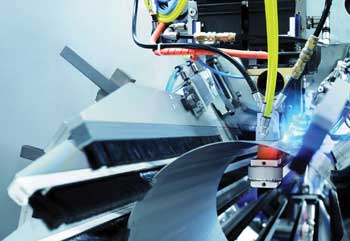
The Flexistar from weil engineering is a flexible manufacturing cell for forming and welding pipes. Neither retrofitting nor mechanical adjustment is required when pipes of different diameters or lengths are welded. Courtesy of weil engineering.
Organizers expect about 200 exhibitors to demonstrate their latest innovations. The program targets specific groups with special shows, including the Stuttgart Laser Marketplace, which is new this year. A special exhibition titled “Future Trends: Made by Laser” will examine current developments in energy, safety, mobility, the environment, and communications and health, with exhibitors demonstrating new component-manufacturing solutions.
The Stuttgart Laser Technology Forum (SLT), representing the international laser industry, will enable knowledge transfer between experts and users, including scientific findings, best-practice examples, developments in laser technology and production applications.
“Meet the Experts” will allow specialists from German laser research institutes to take attendees’ questions on laser processing and recommend suitable manufacturers and service providers.
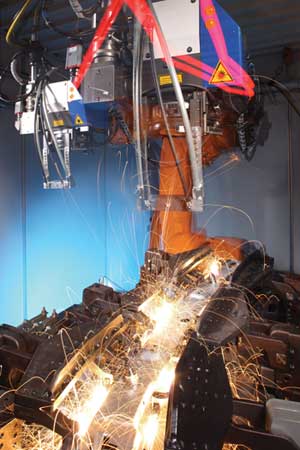
Remote welding with this disk laser provides reliable joining in three dimensions. Courtesy of Fuchs/blz.
A seminar on the markets for materials processing and important trends will allow industry representatives to address the status of various laser applications and technologies as well as macro- and microprocessing.
The industry short course “Basics on Lasers and Laser Material Processing” will teach visitors with little practical experience about laser technology. The focus will be on laser system technology, beam sources and materials processing.
The event will be held concurrently with Engine Expo, Vehicle Dynamics Expo, European Automotive Components, Automotive Testing Expo and Automotive Interiors Expo as well as with O&S, the international trade fair for surface treatments and coatings.
Knowledge transfer
The SLT will allow trade-fair attendees to gain knowledge and further training. In 2010, the forum drew approximately 350 guests and had more than 70 speakers.
There is a special synergy when science meets industry, the organizers say, and the talks will address the laser in materials processing and production from the perspectives of both science and practical use. The exchange of expertise and ideas will influence process and technology improvements or new applications.
SLT will reach a wide audience representing the research, development and production sectors and will even include students. The main focus will be on process safety, erosive precision micromaterials processing, and user experiences regarding innovative laser sources such as disk and fiber lasers.
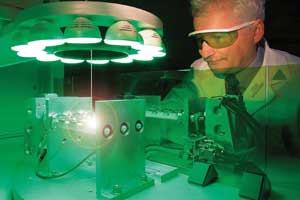
Plastic processing is a highly innovative, research-intensive area of laser technology. Courtesy of LPFK.
Process safety talks will include a look at high-speed laser recordings of processes featuring the video technology of the new x-ray machine at Institut für Strahlwerk-zeuge at the University of Stuttgart (IFSW). Talks on microwelding will show that the gap is slowly closing between macro- and microprocessing, said Dr. Rudolf Weber, head of process development at IFSW. “Thanks to recent developments such as the increase in beam quality for disk lasers or the polarization shaping of disk and CO2 lasers,” Weber said, “the theme of cutting is clearly gaining in importance in the area of macroprocessing.”
Another hot topic, Weber noted, will be laser processing of composite materials such as CFK (carbon fiber-reinforced plastics), which is increasingly being used in the automotive and aircraft industries. But there are still several challenges yet to overcome, according to IFSW experts, in the basic understanding of reciprocal processes that play out in the materials and plant-specific implementation. “In order to achieve the desired productivity,” said professor Thomas Graf, director of IFSW, “there has already been work carried out on corresponding laser beam sources. Ultrashort-pulse lasers with average kilowatt power will soon be available commercially.”

Laserline diode lasers are used in automobile manufacturing for welding aluminum parts. Diode lasers provide good laser beam absorption for such applications. Courtesy of Laserline.
With regard to speed and precision, Weber predicts another great development challenge: being able to move the laser beam over the workpiece quickly enough.
Solution Center
Experts from five laser institutes will share their knowledge of production systems and can even recommend specific exhibitors who could help attendees come up with solutions to problems on the spot.
“The questions can be directed to the participating institutes according to their area of expertise,” said Dr. Marwan Abdou-Ahmed, coordinator of the Solution Center. Abdou-Ahmed is also head of laser development and laser optics at the IFSW.
The advisory team comprises experts from IFSW, Bayerisches Laserzentrum GmbH (blz), Laser Zentrum Hannover eV, Fraunhofer Institute for Material and Beam Technology and Fraunhofer Institute for Laser Technology.
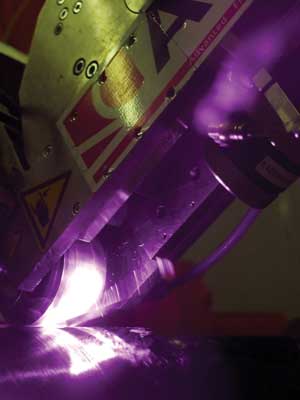
A tape-laying head from AFPT is used in combination with a diode laser and specially developed homogenizing optics from Laserline. Courtesy of AFPT.
The setup was popular with visitors when it was first offered in 2010, said Abdou-Ahmed. The experts who participated in 2010 reported providing visitors with help ranging from a second independent technical opinion to information on completely new laser technology applications in young startups.
“It is a win-win situation for both visitors and experts,” said Dr. Hans-Joachim Krauss, head of services at blz.
“[In 2010,] one company was looking for a service provider of laser beam soldering tests and possible special machine manufacturers for the development of a specific system engineering,” Krauss said. “Here, we explained the current situation with laser soldering and were able to point them towards the right partner.”
‘Lasers in Action’
A forum called “Lasers in Action” will bring together experts from the laser industry to present a comprehensive and varied program of case studies and applications as well as an overview of various laser technologies. Company representatives will demonstrate a broad range of examples of laser materials processing in more than 25 presentations.
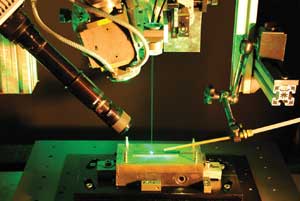
This laser beam combination process for copper welding uses two lasers with green and infrared light. Courtesy of IFSW.
Topics will include the advantages of high-performing femtosecond lasers for industrial microprocessing and mobile laser processing for large workpieces as well as laser microwelding of polymers, medium-pulse CO2 lasers for cutting applications, cutting display glass using picosecond lasers, laser marking in North American medical technology, manufacturing tanks and boilers, and lens formation with the help of diffractive rays for microprocessing.
Additional talks will look at lasers in the automotive industry, from new applications in technology to new perspectives on lightweight-vehicle design, and from current amplifiers for short-pulse lasers to closed loops for laser welding processes.
Event growth
The trade fair grew in 2010, and Messe Stuttgart organizers expect it to do so again this year. The last event brought 3870 visitors – a number that exceeded the 2008 attendance record by more than 400, despite the still-tense economic climate. Visitors came from 39 countries, with the percentage from outside Germany rising from 24 to 30 percent.
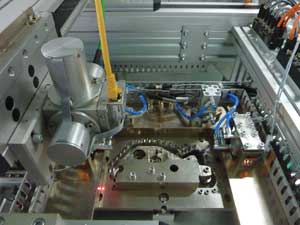
Two transparent plastics can now be welded together, thanks to new laser systems with adapted wavelengths. Courtesy of LPFK.
“[Lasys] is aimed at nearly every industry and at the use of a wide range of materials,” Mayer said. The industries comprise predominantly mechanical engineering and automotive, but also optical, metalworking and processing, electrical engineering and electronics, biomedical technology, plastics and semiconductors.
Exhibitors reported that the quality of visitors in 2010 made them optimistic for the future. “We were able to conduct good discussions at the stand, and the specific project requests suggest that there will be activity in the economy again and an upturn is possible,” said Dr.-Ing. Gerd Schöllhammer, marketing manager for communications/trade fairs at Trumpf Laser- und Systemtechnik GmbH in Ditzingen, Germany.
Lasys 2012
International trade fair for laser materials processing
June 12-14
Messe Stuttgart, Germany
Organized by Landesmesse Stuttgart GmbH
Key Exhibition Areas
Laser production systems
• Turnkey solutions
• Laser units
• Beam transfer
• Workpiece/tool handling/robotics
• Measuring/testing systems
• Safety equipment
• Control
Processes and materials
• Processing methods
• Microprocessing
• Macroprocessing
• Materials
Industry distribution of Lasys attendees*
Mechanical engineering 27%
Automotive engineering 15%
Optical industry 14%
Metal processing industry 13%
Plant and apparatus construction 11%
Electrical/Electronics industry 11%
Medical technology 11%
Precision engineering 9%
Aerospace industry 6%
Semiconductor industry 6%
Plastics industry 5%
Toolmaking and mold making 4%
Services/Design offices 3%
Other industries 17%
*From 2010 postshow report